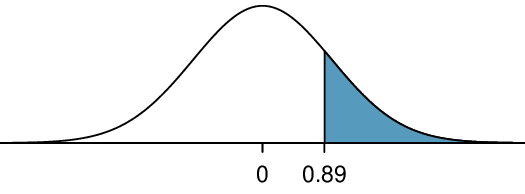Identify: We will test the following hypotheses at the
\(\alpha=10\%\) significance level.
\(H_0\text{:}\) \(p = 0.5\)
\(H_A\text{:}\) \(p > 0.5\) Greater than half of all U.S. adults oppose nuclear energy.
Note:
\(p>0.5\) is what we want to find evidence for; this bears the burden of proof, so this corresponds to
\(H_A\text{.}\)
Choose: Because the hypotheses are about a single proportion, we choose the 1-proportion Z-test.
Check: We must verify that the sample proportion can be modeled using a normal distribution. The problem states that the data come from a random sample. Also,
\(1019(0.5)\geq10\) and
\(1019(1-0.5)\geq10\) so both conditions are met. (Remember to use the hypothesized proportion, not the sample proportion, when checking the conditions for this test.)
Calculate: We will calculate the Z-statistic and the p-value.
\begin{gather*}
Z = \frac{\text{ point estimate } - \text{ null value } }{SE \text{ of estimate } }
\end{gather*}
The point estimate is the sample proportion:
\(\hat{p} = 0.54\text{.}\)
The value hypothesized for the parameter in
\(H_0\) is the null value:
\(p_0 = 0.5\)
The \(SE\) of the sample proportion, assuming \(H_0\) is true, is: \(\sqrt{\frac{p_0(1-p_0)}{n}}= \sqrt{\frac{0.5(1-0.5)}{1019}}\)
\begin{gather*}
Z = \frac{0.54 - 0.5}{\sqrt{\frac{0.5(1-0.5)}{1019}}} = 2.5
\end{gather*}
Because
\(H_A\) uses a greater than sign (
\(>\)), meaning that it is an upper-tail test, the p-value is the area to the
right of
\(Z=2.5\) under the standard normal curve. This area can be found using a normal table or a calculator. The area or p-value =
\(0.006\text{.}\)
Conclude: The p-value of 0.006 is
\(\lt 0.10\text{,}\) so we reject
\(H_0\text{;}\) there is sufficient evidence that greater than half of U.S. adults oppose nuclear energy (as of March 2016).

